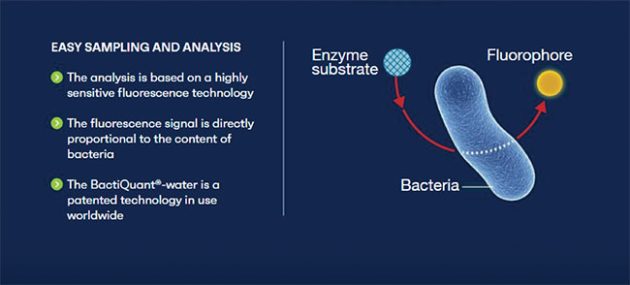
Features
Sponsored Content
Revolutionizing microbial water monitoring
February 1, 2022 Sponsored by by BactiQuant 

“I used BactiQuant to investigate bacterial problems associated with the use of own production of algae feed. I changed to a commercial algae feed, and BactiQuant showed that the bacterial content was reduced dramatically, along with this observation, the high mortality associated with the algae feed was eliminated. It helped me take the right decision based on facts. My experience today is that bacterial load matters for the mortality– I use BactiQuant to get hard facts and it can help me explain my macroscopic observations and rule out a lot of the coincidental fluctuations that can occur. It basically takes the guesswork out of the equation.”
Per Michael Sonnesen, production manager.
1. The problem: Labour-intensive and time-consuming monitoring
The re-use of water in recirculating aquaculture systems (RAS) has significant environmental benefits as water consumption is reduced and the water is cleaned. In RAS however, dissolved compounds and fine particulate organic matter are complicated to remove, leading to a high risk of microparticles accumulating in the system, serving as a food source and a reservoir for bacterial colonization. Traditional methods for monitoring bacterial levels are labour-intensive and have long analysis times, typically two to five days, making them irrelevant in a RAS operation where bacterial numbers can increase exponentially. The high risk of concentrating bacteria and have uncontrolled bacterial proliferation in RAS can lead to disease outbreaks and unstable water quality affecting mortality, fish welfare, and performance.

BactiQuant’s easy-to-use technology, provides a fast and accurate assessment of microbial water quality – reducing the analysis time from days to minutes. The BactiQuant technology is based on a patented method to target an enzyme activity which is naturally occurring in a wide range of bacteria, representing all major taxonomical groups including free-living bacteria as well as, the highly relevant bacteria for aquaculture, particle associated bacteria (PAB). The advantage of the technology is that it provides robust, reproducible, and relevant results that can be readily translated into operational decisions. The return on investment is a few months just by reducing mortality one seventh in a typical RAS production system.
2. The solution: Rapid monitoring BactiQuant to the rescue
Once bacterial growth has occurred it should not take a week to get an analysis result – this challenge led BactiQuant to conceptualize an easy-to-use technology to provide a fast and accurate assessment of bacterial levels. We wanted to provide a process tool that allows the RAS operator to make rapid and relevant operational decisions based on facts. We firmly believe that a stable water quality is the key to reduced mortality, better fish welfare and higher product quality.
Stable water environment: Why rapid bacterial assessment is a necessity and not a luxury
The key to reducing the microbial risk in a RAS is to maintain the water microbiology stable. A stable water environment inhibits opportunistic bacteria to take over the system. Microbial water quality is crucial not only for larvae/juvenile performance in hatcheries, due to detrimental effects bacteria can have on the first sensitive life stages of fish, but also in later stages, to identify problems in RAS such as: the impact and optimization of sanitizing agents, the impact of feed on water quality, the effect of biofilter maintenance, etc. BactiQuant gives producers the opportunity to establish their own individual baseline and compare/benchmark against operating routines or changed assumptions. The unique combination of handheld and online technology provides an unprecedented comprehensive capability to react and follow up on water quality deviations even in saline environments.
“Since we started using BactiQuant our system understanding is much more efficient as we can identify critical points quickly and accurately, which allows early intervention. Data analysis shows any variations in water quality which helps us control diseases associated with bacterial outbreaks.”
– Renata Serradeiro, CEO Acuinova – actividades piscicolas, S A., Aquinova.
 Today the use of the BactiQuant method has been implemented at several large-scale RAS facilities around the world as a process monitoring tool. Companies such as Huon Aquaculture, Aquinova, Sashimi Royal, Danish Salmon and others have given us their vote of confidence.
Today the use of the BactiQuant method has been implemented at several large-scale RAS facilities around the world as a process monitoring tool. Companies such as Huon Aquaculture, Aquinova, Sashimi Royal, Danish Salmon and others have given us their vote of confidence.
To show our commitment to the environment, at BactiQuant we have aligned our business with four of the UN’s Sustainable Development Goals, to help companies ensure optimum usage and handling of water to the benefit of customers and sustainability of our planet.
To learn more about the technology and competences of BactiQuant, go to www.bactiquant.com, connect with Christina Katsaiti on LinkedIn, or reach out to the team at BactiQuant on info@bactiquant.com.
Print this page

